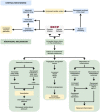Enhanced external counterpulsation: A unique treatment for the "No-Option" refractory angina patient
- PMID: 33410549
- PMCID: PMC7986429
- DOI: 10.1111/jcpt.13330
Enhanced external counterpulsation: A unique treatment for the "No-Option" refractory angina patient
Abstract
What is known and objectives: Coronary artery disease (CAD) is the leading cause of death in the United States. For patients on whom guideline-driven measures have been tried, enhanced external counterpulsation (EECP) is the only truly noninvasive and safe intervention for which a reduction of angina symptoms and nitrate use, increased exercise tolerance, and improvement in myocardial ischaemia have been shown. The objective of this study was to demonstrate, by way of literature review, the efficacy of EECP as a treatment modality for the relief of refractory angina and improvement in quality of life in CAD patients.
Methods: This article reviewed the safety and efficacy of EECP in patients with refractory angina, by conducting a sweeping search and analysis of existing published literature.
Results and discussion: Critical review of a multitude of studies revealed that EECP consistently reduces angina pectoris, extends time to exercise-induced ischaemia, decreases dependency on nitroglycerine for frequent chest pain, increases maximum workload, and improves the quality of life in patients with symptomatic stable angina. The literature reviewed also indicated that EECP is well-tolerated by the vast majority of patients, with relatively few adverse events reported.
Conclusion: The present study suggests that EECP is a safe and likely best available method of treatment for patients presenting with symptomatic CAD not amenable to further revascularization.
Keywords: EECP; angina pectoris; coronary artery disease.
© 2021 The Authors. Journal of Clinical Pharmacy and Therapeutics published by John Wiley & Sons Ltd.
Conflict of interest statement
The authors have no financial disclosures or conflicts of interest to report.
Figures



Similar articles
-
Enhanced External Counterpulsation (EECP): An Evidence-Based Analysis.Ont Health Technol Assess Ser. 2006;6(5):1-70. Epub 2006 Mar 1. Ont Health Technol Assess Ser. 2006. PMID: 23074496 Free PMC article.
-
The multicenter study of enhanced external counterpulsation (MUST-EECP): effect of EECP on exercise-induced myocardial ischemia and anginal episodes.J Am Coll Cardiol. 1999 Jun;33(7):1833-40. doi: 10.1016/s0735-1097(99)00140-0. J Am Coll Cardiol. 1999. PMID: 10362181 Clinical Trial.
-
The immediate and long-term outcome of enhanced external counterpulsation in treatment of chronic stable refractory angina.J Intern Med. 2006 Mar;259(3):276-84. doi: 10.1111/j.1365-2796.2005.01604.x. J Intern Med. 2006. PMID: 16476105
-
Enhanced external counterpulsation: a novel therapy for angina.Complement Ther Clin Pract. 2012 Nov;18(4):197-203. doi: 10.1016/j.ctcp.2012.06.004. Epub 2012 Jul 15. Complement Ther Clin Pract. 2012. PMID: 23059432 Review.
-
Enhanced external counterpulsation: an innovative physical therapy for refractory angina.PM R. 2009 Mar;1(3):268-76. doi: 10.1016/j.pmrj.2008.12.002. PM R. 2009. PMID: 19627906 Review.
Cited by
-
Effects of Enhanced External Counterpulsation With Different Sequential Levels on Lower Extremity Hemodynamics.Front Cardiovasc Med. 2021 Dec 24;8:795697. doi: 10.3389/fcvm.2021.795697. eCollection 2021. Front Cardiovasc Med. 2021. PMID: 35004907 Free PMC article.
-
Coronary Microvascular Dysfunction and Vasospastic Angina-Pathophysiology, Diagnosis and Management Strategies.J Clin Med. 2025 Feb 10;14(4):1128. doi: 10.3390/jcm14041128. J Clin Med. 2025. PMID: 40004660 Free PMC article. Review.
-
Enhanced External Counterpulsation Outcomes Study: Retrospective Analyses of Data Obtained from Patients at a Single Medical Center in United States.Int J Angiol. 2024 Mar 30;33(3):182-188. doi: 10.1055/s-0044-1782657. eCollection 2024 Sep. Int J Angiol. 2024. PMID: 39131809 Free PMC article.
-
Effects of Cardiac Rehabilitation Combined with Enhanced External Counterpulsation on Heart Rate Variability and Autonomic Nervous Function in Chronic Heart Failure.Cardiovasc Toxicol. 2025 Aug 6. doi: 10.1007/s12012-025-10027-1. Online ahead of print. Cardiovasc Toxicol. 2025. PMID: 40768015
-
Myocardial strain and refractory angina: an intriguing puzzle.Int J Cardiovasc Imaging. 2021 Aug;37(8):2491-2495. doi: 10.1007/s10554-021-02310-3. Epub 2021 Jul 2. Int J Cardiovasc Imaging. 2021. PMID: 34213675 No abstract available.
References
-
- Benjamin EJ, Muntner P, Alonso A, et al. Heart disease and stroke statistics ‐ 2019 update: a report from the American Heart Association. Circulation. 2019;139:e56‐e528. - PubMed
-
- Fihn SD, Blankenship JC, Alexander KP, et al. 2014 ACC/AHA/AATS/PCNA/SCAI/STS focused update of the guideline for the diagnosis and management of patients with stable ischemic heart disease: a report of the American College of Cardiology/American Heart Association Task Force on Practice Guidelines, and the American Association for Thoracic Surgery, Preventive Cardiovascular Nurses Association, Society for Cardiovascular Angiography and Interventions, and Society of Thoracic Surgeons. Circulation. 2014;130:1749‐1767. - PubMed
-
- Shah SA, Shapiro RJ, Mehta R, et al. Impact of enhanced external counterpulsation on Canadian Cardiovascular Society angina class in patients with chronic stable angina: a meta‐analysis. Pharmacotherapy. 2010;30(7):639‐645. - PubMed
Publication types
MeSH terms
Substances
LinkOut - more resources
Full Text Sources
Other Literature Sources
Medical
Miscellaneous

